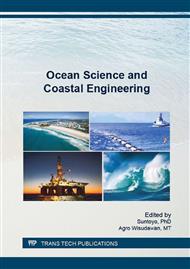p.174
p.182
p.189
p.197
p.202
p.208
p.214
p.220
p.226
A Petri Net Model and its Simulation for Straddle Carrier Direct-System Operation in a Container Terminal
Abstract:
This paper presents a petri net model for examining effectiveness of straddle carrier direct-system operation. Dynamic of operation is addressed by formal petri net model that affiliates types of operation and sequences of motion for various agents in container terminal. An interchange model in the petri net is introduced to represent transloading process that controls the flow of containers between agents. In addition, simulation model was developed to examine the deployment scenarios of gantry cranes, straddle carriers and truck slots at transfer point. The results suggest terminal performance indicators such as level of productivity, waiting time and equipment’s idle time for each deployment scenarios which is beneficial as decision support systems for efficient management of terminal equipment.
Info:
Periodical:
Pages:
202-207
Citation:
Online since:
January 2017
Authors:
Keywords:
Price:
Сopyright:
© 2017 Trans Tech Publications Ltd. All Rights Reserved
Share:
Citation:


